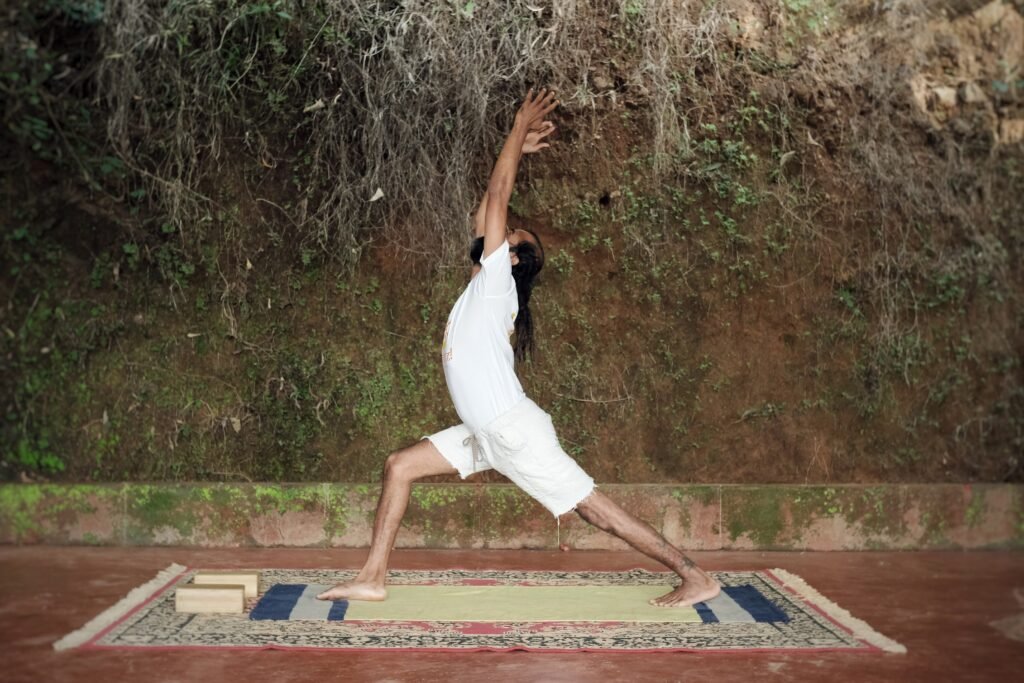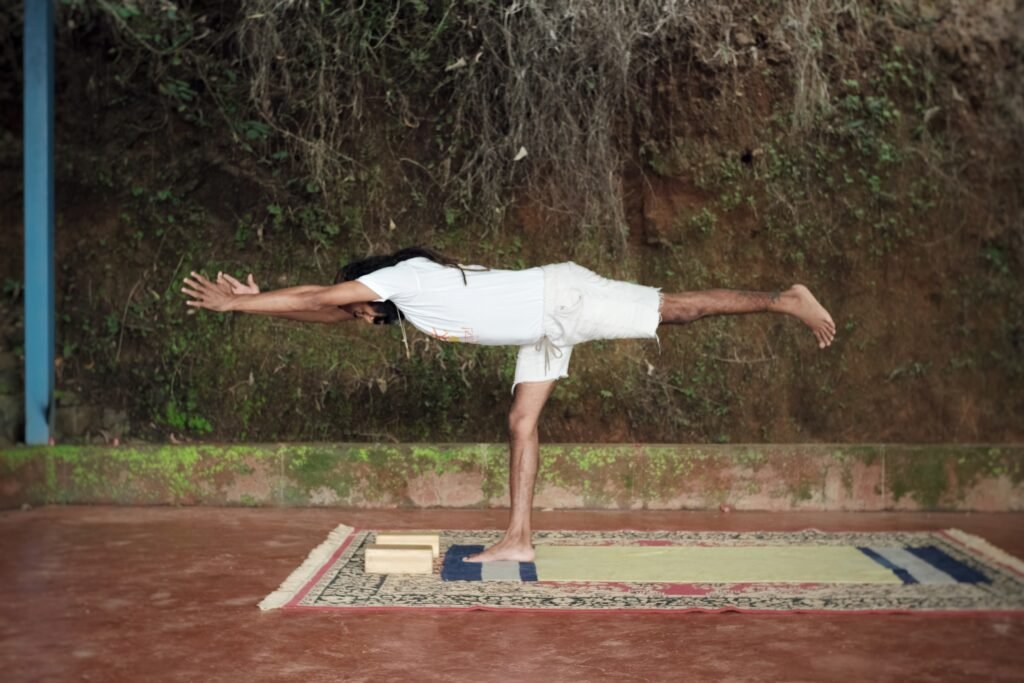
A dynamic vinyasa flow called Warrior Pose Flow (Virabhadrasana Vinyasa) combines several Virabhadrasana variations. Take note of how the poses are transitioned from one level of yoga to the next.
In this sequence, Virabhadrasana (Warrior Pose), Virabhadrasana II (Warrior Pose II), and Viparita Virabhadrasana (Reverse Warrior Pose), a backbend balancing yoga pose, are used to demonstrate the need to warm up the body (in this case, the legs and lower back) to prepare for the peak pose, Virabhadrasana III (Warrior Pose III), Each pose is more difficult when executed dynamically because it is timed with either an inhalation or an exhalation.
By practicing this peak pose, yoga practitioners can move slowly and steadily while learning about the body’s flexibility and strength. This short yoga flow sequence can be practiced repeatedly to help overcome fears and inhibitions in the best possible way.
It can also be incorporated into power yoga, assisting advanced students in developing self-assurance and willpower both physically and mentally.
As a result, this flow promotes the development of upper and lower body strength and endurance. Students may eventually discover strength in their physical and mental bodies as they advance in their practice, as suggested by the name “Warrior.”
STEPS FOR WARRIOR POSE:
- Start in the downward-facing dog pose (Adho Mukha Svanasana) and step your right foot forward until your toes are in line with your fingertips. Then, move your foot just a little bit to the right.
- Slightly stoop your front knee. Your right outer hip should be pinned back, your knee should be stacked over your ankle, and your thigh should be nearly parallel to the floor.
- Rotate your left heel to be 45 degrees away from the side of the mat. Place the feet slightly wider to increase stability or align your left heel with your right heel.
- To straighten your left knee, press your left thighbone back.
- Raise your arms overhead with your palms facing each other and your shoulders apart as you inhale. Let them open up and outward to move your shoulder blades toward your outer armpits and away from your spine. Bring your triceps into your midline and rotate your biceps back. You can look up at your thumbs while bringing your palms together.
- Let go of your tailbone while pushing your left femur back. Pull your lower belly away from your right thigh and up.
- Hold for five to ten breaths.
- Let go of your hands and return to Downward-Facing Dog. Repeat on the opposite side.

Benefits of Warrior Pose Flow:
-
Lengthens, Strengthens, and Stretches:
With the knee bent and the foot firmly planted on the floor, a deep stretch is achieved at the hamstring muscles, which also causes the hamstrings to extend to their fullest potential. It fortifies the knee, hip, and ankle joints.
-
-
Flexibility and Range of Motion:
-
Dynamic movements test the joints’ range of motion, gradually increasing overall flexibility and stability. Enhancing spinal flexibility is the movement from a neutral spine alignment to an extended spine position, followed by a lateral spine bend. The body is better prepared for other flows like Dancing Warrior, Dancing Warrior II, and others, thanks to this improved flexibility of the spine, hips, shoulders, and knees.
-
-
Chest, Diaphragm, and Breath:
-
The arms are pretty active in each pose in this flow, and the torso is stretched in each pose differently.In the first pose, it is stretched vertically; in the second, it is neutral; in the third, it is in a forward bend; in the fourth, it is in a backbend.
These movements significantly negatively impact the intercostal muscles’ ability to function because they also significantly affect the chest, rib cage, side abdominal muscles, upper back, and upper abdomen (breathing muscles).
The flow’s breathing is primarily thoracic, and a strong core is required to achieve proper alignment and controlled movement.When the flow is performed rhythmically, the dynamic movements that result from the efficient use of the diaphragm and breathing muscles cause an increase in heart rate.
-
-
Awareness, Concentration, Posture, and Alignment:
-
The breath plays a significant role in this dynamic flow as you transition between the poses, ensuring a seamless transition.In addition to being aware of one’s breath, other factors that contribute to the successful support of the body during yoga poses include having the feet firmly planted on the ground, having the knee aligned with the ankle, having the shoulder aligned over the hips, maintaining a broad chest, lengthening the spine, evenly distributing the body weight, and having the drishti in the correct position. When students consistently practice this level of awareness, concentration, and alignment, the flow becomes effortless, and the likelihood of injury decreases.
Additionally, one of the most essential tools for performing the Virabhadrasana series is balancing the body and evenly distributing weight.This flow also strengthens the body’s muscular framework, contributing to a strong spine by fostering good posture and body balance.
-
-
Refreshing, de-stressing, and energizing:
-
The deep stretching of the arms, shoulders, and neck significantly impacts breathing.
As a gentle heart opener, it encourages deeper inhalations and the downward flow of energy (apana vayu) with active hips and pelvis. The body feels energized and stress-free due to the release of extra energy and the fresh energy flow.
The dynamic flow raises the heart rate and functions as an effective cardiovascular workout. It also contributes to an increase in the amount of energy and stamina that are present in the body and the mind. Finally, the free flow of prana helps to relax the nervous system.
-
-
Stimulation of Organs, Circulation, and Systems:
-
When the muscles are activated, including the abdominal muscles, the digestive and reproductive systems improve their functions. This results in a reduction in symptoms of indigestion and problems related to the reproductive system.
This cardiovascular exercise quickens the heart rate and stretches the muscles in the body, which opens up the channel for more efficient blood circulation. Dynamic movements are produced as a result of the flow, and the respiratory system benefits from the intercostal muscle stretch and the rhythmic breathing required to move through the flow.
The powerful alignments required in the flow create the strong musculoskeletal system.
-
-
Balance and Emotions:
-
Virabhadrasana Vinyasa builds mental strength in addition to a strong musculoskeletal framework for the physical body. The physical and mental stability necessary for the flow fosters confidence in the body and the mind.
-
-
Other:
-
This flow is beneficial for women because it targets the hip and pelvic region; it is also beneficial for teenagers because it is a dynamic flow that will improve their energy levels; it is beneficial for athletes because it strengthens the core, leg muscles, and back; and it is beneficial for sports because it improves flexibility. This flow targets the entire body, stimulating various joints, muscles, organs, blood vessels, and other bodily systems. Given the numerous advantages outlined above, it can also be introduced to dancers, martial artists, gymnasts, etc.
Warrior Pose Contraindications
- Injury and surgery: Because this pose requires joint strength, students with ankle, foot, shoulder, or knee injuries should avoid it. A person who has recently undergone surgery on their ankle, shoulder, hip, or spine should stay away from this flow to reduce their risk of sustaining additional injuries or developing complications.
- Disconnections Between the Body and the Breath: In this flow, moving from one pose to the next requires not only forward momentum of the body but also conscious awareness of the breath. A student who lacks this will have an unbalanced posture that may result in injuries.
- Physical Strength and Weak Body: Students with weak joints or musculoskeletal frames should avoid this pose. Additionally, individuals who suffer from high blood pressure, heart conditions, vertigo, or any other issues related to their equilibrium should stay away from this flow. Students who have been through emotional trauma should steer clear of this flow because it poses a significant challenge for their sluggish bodies and anxious minds and should be avoided at all costs. It disrupts their already-upset comfort zone, which is a challenge for them.
- Others: Because it strains the joints and muscles, pregnant women, women who have recently given birth, and senior citizens should steer clear of this pose.
